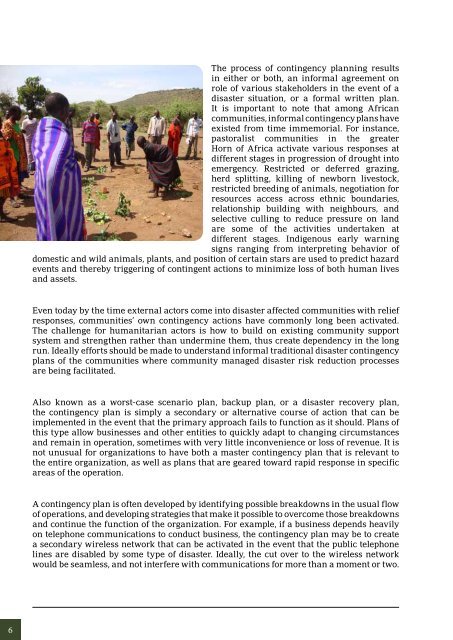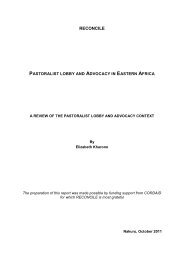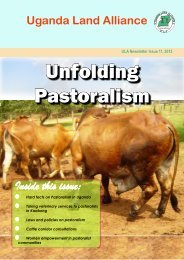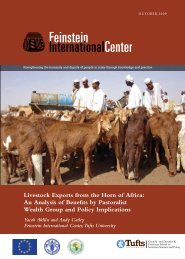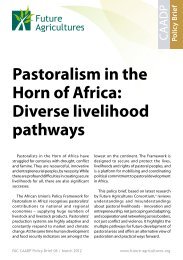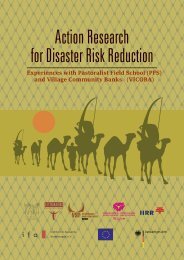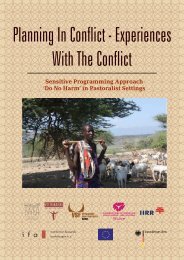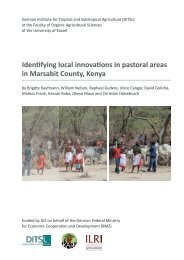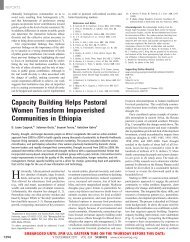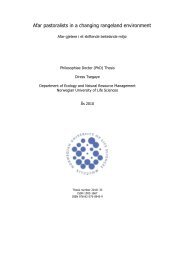Drought Contingency Planning with Pastoral Communities - celep
Drought Contingency Planning with Pastoral Communities - celep
Drought Contingency Planning with Pastoral Communities - celep
You also want an ePaper? Increase the reach of your titles
YUMPU automatically turns print PDFs into web optimized ePapers that Google loves.
The process of contingency planning results<br />
in either or both, an informal agreement on<br />
role of various stakeholders in the event of a<br />
disaster situation, or a formal written plan.<br />
It is important to note that among African<br />
communities, informal contingency plans have<br />
existed from time immemorial. For instance,<br />
pastoralist communities in the greater<br />
Horn of Africa activate various responses at<br />
different stages in progression of drought into<br />
emergency. Restricted or deferred grazing,<br />
herd splitting, killing of newborn livestock,<br />
restricted breeding of animals, negotiation for<br />
resources access across ethnic boundaries,<br />
relationship building <strong>with</strong> neighbours, and<br />
selective culling to reduce pressure on land<br />
are some of the activities undertaken at<br />
different stages. Indigenous early warning<br />
signs ranging from interpreting behavior of<br />
domestic and wild animals, plants, and position of certain stars are used to predict hazard<br />
events and thereby triggering of contingent actions to minimize loss of both human lives<br />
and assets.<br />
Even today by the time external actors come into disaster affected communities <strong>with</strong> relief<br />
responses, communities’ own contingency actions have commonly long been activated.<br />
The challenge for humanitarian actors is how to build on existing community support<br />
system and strengthen rather than undermine them, thus create dependency in the long<br />
run. Ideally efforts should be made to understand informal traditional disaster contingency<br />
plans of the communities where community managed disaster risk reduction processes<br />
are being facilitated.<br />
Also known as a worst-case scenario plan, backup plan, or a disaster recovery plan,<br />
the contingency plan is simply a secondary or alternative course of action that can be<br />
implemented in the event that the primary approach fails to function as it should. Plans of<br />
this type allow businesses and other entities to quickly adapt to changing circumstances<br />
and remain in operation, sometimes <strong>with</strong> very little inconvenience or loss of revenue. It is<br />
not unusual for organizations to have both a master contingency plan that is relevant to<br />
the entire organization, as well as plans that are geared toward rapid response in specific<br />
areas of the operation.<br />
A contingency plan is often developed by identifying possible breakdowns in the usual flow<br />
of operations, and developing strategies that make it possible to overcome those breakdowns<br />
and continue the function of the organization. For example, if a business depends heavily<br />
on telephone communications to conduct business, the contingency plan may be to create<br />
a secondary wireless network that can be activated in the event that the public telephone<br />
lines are disabled by some type of disaster. Ideally, the cut over to the wireless network<br />
would be seamless, and not interfere <strong>with</strong> communications for more than a moment or two.<br />
6


